| |
 
CHURCHES OF
THE GOLDEN VALLEY
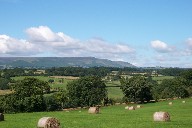 |
|
Nearly forty years
ago Nikolaus Pevsner wrote: “There
are not many counties in England of which
it can be said that, wherever one goes,
there will not be a mile which is
visually unrewarding or painful.”
Traffic in Hereford itself is horrendous
nowadays, and things may have changed
marginally elsewhere in the county, but
the Golden Valley, the valley of the
River Dore, still reflects all that he
and many others have written, extolling
the delights of this most secret place.
The Dore rises not far from Hay-on-Wye
and joins the Monnow at Pontrilas, near
the mediaeval fortress of Ewyas Harold,
built by William FitzOsbern in the late
11th century. |
With its associated stream,
the Escley Brook, it flows south-east parallel to
the upper reaches of the Monnow itself, its
gently wooded hillsides dominated by the towering
outline of the Black Mountains to the west.It is
a magical valley, its name possibly deriving from
the Welsh “dwr”, meaning
“water”, or possibly the French monks
of Dore Abbey’s mistranslation of
“d’or”, French for
“gold”.
The churches of the area are justly celebrated.
All of them are open and welcoming to visitors
and obviously greatly loved by parishioners. They
have one unifying element: most of them are of
Norman origin, reflecting the power of the Barons
who protected England from the marauding Welsh.
Three in particular, can be attributed to the
same builders: Kilpeck, Moccas and Peterchurch.
The first two are small three cell buildings of
nave, chancel and apse, whilst Peterchurch is on
a larger scale with a fourth cell suggesting
there was once a central tower. All have details
in common, either a moulded string course round
the apse or flat vertical buttresses. Rowlstone,
with its square east end, is linked also to
Kilpeck by virtue of its sculptured south
doorway, but the jewel of the valley is what
remains of the great Abbey of Dore. No county,
wrote John Betjeman, has a church as wonderful as
Abbey Dore, whilst Simon Jenkins describes it as
“a corner of France dropped into an English
meadow….a most sublime spot.” Yet to my
mind it is quintessentially English.
*****
ABBEY DORE,
St. Mary (formerly DORE ABBEY)
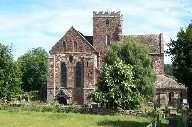 |
|
Dore Abbey was
founded by twelve monks from Morimond,
the least known of the five great
Cistercian houses in France, in 1147.
Morimond had daughter houses in many
parts of Europe, though Dore was the only
one in England. Perhaps Robert, Earl of
Ewyas, met the Abbot of Morimond on the
Second Crusade, and offered him land in
Herefordshire.
What remains today are the crossing,
transepts and chancel of the monastic
church, together with a seventeenth
century tower, all built of red
sandstone. The nave was pulled down at
the Dissolution in 1537, together with
all the conventional buildings, and the
remainder fell into gradual disrepair,
until it was restored by Viscount
Scudamore in the 17th century. |
Scudamore obtained the
services of John Abel to design new roofs, the
screen which separates the transepts from the
chancel and other furnishings, as well as the
glass which adorns the east window. The minstrels
gallery was placed against the west wall in the
first decade of the 18th century. Further periods
of neglect followed, and the furnishings were
once again repaired and re-ordered, this time by
a local architect, Roland Paul, beginning in
1901, and it is noticeable that much love and
pride is bestowed on the great church today.
The great feature
of Dore Abbey is the sumptuous Early
English chancel and the eastern piers,
each with fourteen shafts, the triple
lancet widows, and the double ambulatory,
each of its four pillars having eight
shafts. This composition has been
mentioned in the same breath as the east
end of Wells Cathedral by more than one
writer, and no praise could be higher.
Only the profusion of architectural
fragments which litter the floor of the
ambulatory are an eyesore, though not so
the magnificent bosses, rescued from the
nave roof, which can be examined at close
quarters: the Coronation of the Virgin,
Christ in Majesty, a monk kneeling before
St Catherine, and another kneeling before
the Virgin. Many retain traces of colour.
I first came here nearly half a century
ago, but Dore Abbey is a church to be
visited again and again; the rewards just
get greater and greater..
|
|
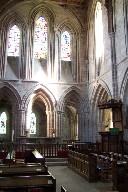 |
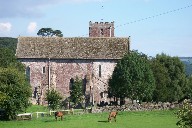 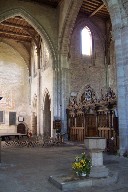 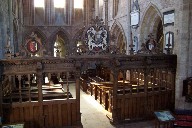
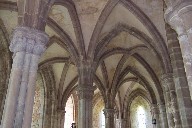 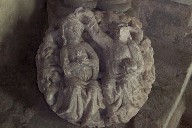
*****
BACTON, St. Faith
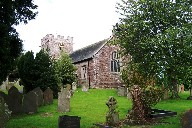 |
|
A small church
close by Abbeydore, with nave and chancel
in one. Notable for the alabaster effigy
of Blanche Perry, a maid-in-waiting to
Queen Elizabeth I, before whom she
kneels. The long inscription ends thus:
SO THAT MY THYME I THUS DYD PASSE AWAYE
A MAEDE IN COURTE AND NEVER NO MANS WYFFE
SWORNE OF QUENE ELLSBETHS HEDD CHAMBER
ALLWAYS
WYTHE MAEDEN QUENE A MAEDE DYD ENDE MY
LYFFE |
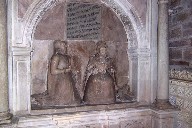
*****
BREDWARDINE, St. Andrew
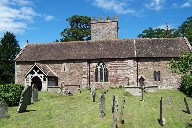 |
|
The nave is early
Norman, with herring-bone masonry on the
lower part of the north wall, originally
with doorways north and south. The former
is blocked, but the latter remains,
complete with an enormous lintel, carved
with rosettes. It also shares a heavily
rolled moulding with the south door at
Rowlstone. The chancel was rebuilt in the
14th century at an angle to the nave, and
contains two large tombs. On the north
side, the damaged effigy of a knight,
possibly Walter Baskerville, who died in
1369, and on the south a finely carved
alabaster effigy, thought to be Sir Roger
Vaughan, who succeeded Baskerville to the
Lordship of the Manor, and was killed at
Agincourt in 1415. The tower was added in
1790, on the north side of the church,
possibly replacing a Norman central
tower. |
Bredwardine
stands close to the River Wye, at the foot of a
steep hill, and is a renowned beauty spot. The
diarist Francis Kilvert was Rector from 1877
until his death two years later.
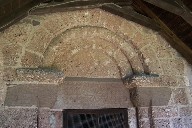 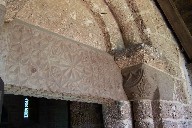
*****
CLODOCK, St. Clydawg
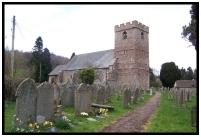 |
|
Christianity came
to Clodock early in the 6th century, when
Clydawg, son of the King of Ewyas, was
murdered during a hunting
expedition. He was buried
near the riverbank, and a column of fire
was seen to rise from the grave,
prompting the local Bishop to order an
oratory to be built on the site.
The walls of the present church date from
Norman times, and the living became the
responsibility of Llanthony Priory, a
short distance across the Black
Mountains. The internal
furnishings date almost entirely from the
reforms of Archbishop Laud, retaining the
original altar and three sided rails,
three decker pulpit with tester and
a complete set of box
pews. There is a large west
gallery of about 1700, complete with the
original music desk. Like St.
Margaret’s, Clocock remained under
the jurisdiction of St. David’s
until transferred to the Diocese of
Hereford in 1858. |
In the
churchyard there are nearly 900 gravestones,
mainly from the 18th and 19th centuries, all in
their original positions. By all
accounts some 1600 burials were recorded in the
parish between 1813 and 1850. Where
did they all come from?
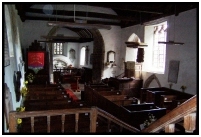 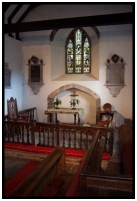 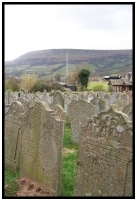
*****
KILPECK, St. Mary & St. David
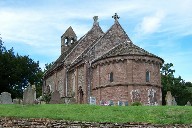 |
|
Even if it were
not adorned by some of the best and most
original sculpture in England, Kilpeck
would still be marked down as one of the
finest and most complete Norman village
churches, and of all the churches in
Herefordshire it receives the most
visitors. It is built of red sandstone
and consists of nave, chancel and apse,
with just a bell-cote added later. The
exterior is punctuated by flat
buttresses, and a corbel table runs all
round.
But it is the carving that makes Kilpeck
famous, for it represents the finest
remaining work of the so-called
Herefordshire school of carvers, whose
work began at Shobdon in 1140 and moved
to Kilpeck in about 1145. |
Far removed from the
mainstream of Norman sculpture, the carvings show
the influence of the Vikings, Saxons, Celts,
Franks and Spaniards, and display a vigour and
originality not found elsewhere. On the corbel
table we find sacred motifs (the Lamb and Cross),
animals (notably a lovable dog and rabbit),
wrestlers, a female exhibitionist (a
Sheila-na-gig) and many other comic-strip
figures. The south door is sumptuously decorated.
The tympanum shows a Tree of Life, whilst the
outer order of the arch is decorated with linked
medalions containing dragons and birds.
The shafts consist of thick
snake-like bodies, with two long wiry figures,
whose pointed caps and tight clothes have the
parallel folds like ribs that are characteristic
of the School. There is decoration on the west
front, too. The window has shafts of beaded bands
of interlace, and three magnificent dragons heads
protrude from the wall. Many of these motifs
recur at other Herefordshire churches, and
occasionally in neighbouring Shropshire and
Worcestershire, though not elsewhere.
| The interior is
equally exciting. The apse is
rib-vaulted, and the ribs are decorated
with zig-zag, as is the chancel arch, but
each vertical pillar of the arch has
three carved figures, one above the
other, including St. Peter and St. Paul,
a most unusual feature, again suggestive
of the innovative local school of
carvers. Pevsner, in fact, makes an
interesting suggestion that the church
may have been begun in about 1135 and
that ten years later the Shobdon workshop
moved in to decorate Kilpeck when their
work there was done. |
|
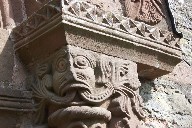 |
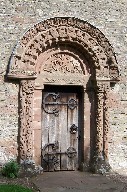 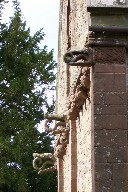 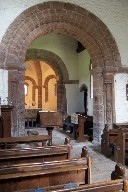 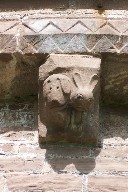 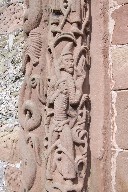
*****
MADLEY, Nativity of the Blessed Virgin Mary
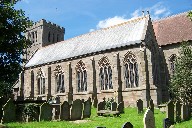 |
|
An unusually large
and beautiful church. The rare dedication
refers to the statue of the Virgin which
was housed in the crypt during the Middle
Ages, making Madley a centre of
pilgrimage. This crypt, with its central
pillar, has recently been restored.
The present church dates from three
distinct periods of building. Of the
original Norman cruciform church only the
north transept remains as what is now the
north porch. About 1220 it was largely
pulled down to make way for a new nave
with aisles, chancel and tower, whilst a
hundred years later the chancel was again
rebuilt in the French style, with a
sumptuous polygonal apse. The crypt was
also built at this time, and shortly
afterwards the Chilston Chapel, in effect
an outer south aisle, was added. |
The most memorable features
of the church all date from this last rebuilding.
The east window has reticulated tracery whilst
its two companions have the latest geometric
tracery. There is a profusion of ball-flower
decoration both inside and out: on the sedilla
and in a frieze immediately below the eaves. It
also appears on the elegant windows of the
Chilston Chapel. The east window contains some
beautiful stained glass, the most notable being
three panels from an early 14th century tree of
Jesse, including perfectly preserved panels
depicting Ezekiel and King Josias. The choir
stalls, complete with simple misericords also
date from the 14th century, whilst the huge
Norman font (c.f. Bredwardine and Kilpeck) is
said to be one of the largest in England.
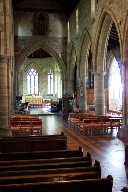 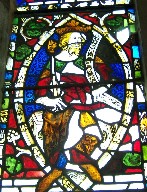 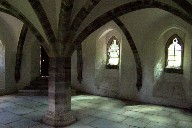
*****
MOCCAS, St. Michael
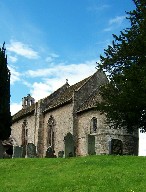 |
|
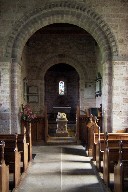 |
|
Take away the
bellcote and two 13th century windows and
Moccas remains the perfect Norman village
church: nave, chancel and apse. Not that
any village remains nearby today, for the
church is situated alone in the grounds
of Moccas Court, built in 1775 close to
the River Wye, to designs by Robert Adam.
The first church at Moccas was founded by
the Welsh Saint, St. Dubriciuth, and
rebuilt on high ground in the second
quarter of the 12th century to designs
familiar from Kilpeck and Peterchurch,
though in fact Moccas may have come
first. The apse has the moulded string
course below the window line similar to
the other two, but no pilasters. The nave
has two Norman doorways with badly eroded
tympana. |
That on the south has a
tree of life flanked by human figures and animals
(c.f. Kilpeck). The north windows contain two
complete and beautiful stained glass canopies of
the 14th century, and in the centre stands an
early 14th century tomb-chest surmounted by the
effigy of a cross-legged Knight, which has been
badly re-tooled.
*****
PETERCHURCH, St. Peter
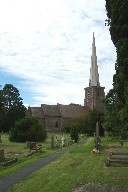 |
|
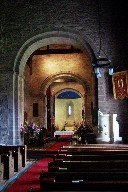 |
|
At first glance
the most distinctive feature of St.
Peter’s is the tall broach spire,
made of fibreglass and lowered on to the
tower by helicopter in 1972. It is
gleaming white and visible from miles
around. Hopefully it will mellow with
age. The main body of the church is an
unusually large and important Norman
structure consisting of four parts: a
nave, an apse and, apparently, two
chancels. As one of these is square, it
presumably supported a central tower at
one time. Pevsner describes the sequence
of arches as memorable, two surmounted by
saltire crosses and one decorated with
zig-zag. The roof of the apse is painted
blue with golden stars, another memorable
effect. Externally the apse is similar to
Kilpeck, with a roll moulding below the
windows and flat pilasters. The view
would be greatly improved if some of the
trees and shrubs close to the apse were
removed. |
*****
ROWLESTONE, St. Peter
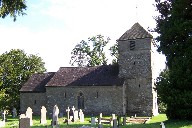 |
|
On high ground
between the River Monnow and Dulas Brook,
St. Peter’s was originally a simple
Norman building of about 1130, of a nave
and chancel, although it has been
suggested that there may have been an
apse (c.f. Kilpeck, Moccas). The present
east wall was reconstructed in the 15th
century, when the large north window was
also inserted into the nave, and the
tower with its pyramid roof added in the
16th century.
The importance of Rowlestone lies in its
carved decoration, executed by the same
sculptors who worked at Shobdon and
Kilpeck. The Christ in Majesty in the
tympanum above the south doorway is
surely one of the master’s finest
works, almost identical with the lost
Majesty at Shobdon. |
The figure is in a halo,
with the knees wide apart and the feet together,
and the skirt having the tense, stringy folds
characteristic of the Herefordshire School. The
four supporting angels fly upside down, making a
highly accomplished composition. The heavy roll
moulding above the door is supported on capitals
decorated with birds and a Green Man.
The chancel arch is equally impressive. The same
birds are there (an obsession with the
Herefordshire carvers) and figures of winged
angels and haloed figures. Those on the south are
set upside down. Could this have been
carelessness, as Pevsner suggests, or a reference
to the legend that St. Peter was crucified upside
down? Above both capitals the abaci are carved
with further bird motifs, echoed once again in
the two 14th century iron candle brackets in the
chancel. Rowlestone Church deserves to be much
better known; many of those who visit Kilpeck,
not five miles away, have never heard of it.
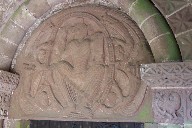 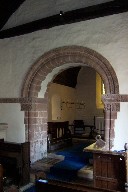 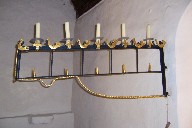
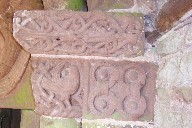 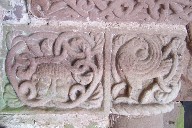 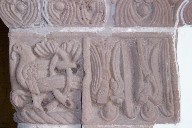
*****
ST. MARGARET’S, St. Margaret
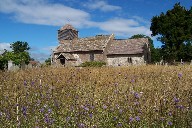 |
|
The thrill of St.
Margaret’s is best summed up in the
words of John Betjeman. “My own
memory of the perfect
Herefordshire,” he wrote in 1958,
“is a spring day in the foothills of
the Black Mountains and finding among
winding hilltop lanes the remote little
church of St. Margaret’s, where
there was no sound but a farm dog’s
distant barking. Opening the church door
I saw across the whole width of the
little chancel a screen and loft all
delicately carved and textured pale grey
with time.” Set in a large churchyard
which in summer resembles a wild flower
meadow alive with grasshoppers and
butterflies, St. Margaret’s consists
of a nave and chancel with an oversized
weatherboarded turret.
|
It is basically Norman with
later additions, but everything pales into
insignificance before the screen, described by
Pevsner as one of the wonders of Herefordshire.
It is really a loft resting on two carved posts,
their delicate, lacy ornament surrounding two
little niches near the top. The delicate carved
foliage on the front of the loft is in well nigh
perfect condition, and the coving has ribs
meeting at right angles, with tiny carved bosses
at each junction. The screen is similar to
several in Wales, including that at Patrishow,
not far away across the Black Mountains, and
similarly remote. Until 1852, St.
Margaret’s, together with other churches in
the Hundred of Eywas, was in the Diocese of St.
David’s. It has recently been
sympathetically re-roofed, and despite its
remoteness it is always open and holds regular
services as well as an annual Flower Festival.
St. Margaret’s is one of the few places
which are as thrilling to visit for the twentieth
time as for the first, although it certainly
doesn’t get any easier to find! Its peace
and serenity remain as potent today as they did
fifty years ago.
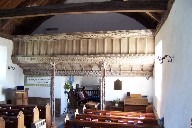 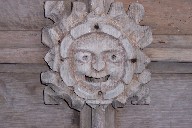 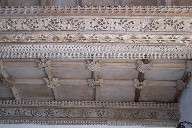
*****
TURNASTONE, S. Mary Magdelene
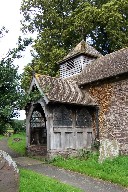 |
|
A small mediaeval
church standing less than half a mile
from Vowchurch, on the road to
Michaelchurch Escley. The nave and
chancel are all in one, crowned by a
handsome ceiled wagon roof with bosses.
The south doorway is late Norman,
decorated with very rustic carved
capitals. At the west end is an
attractive little weatherboarded. bell
turret with a pyramid roof.
| There are
two monuments of note: an incised
slab of 1522 to Thomas Aparri and
his wife, their portraits
embellished by a little satyr in
a big hat playing a pipe, and a
copiously decorated tablet with
figurines to Mrs Tranter, of
1685. |
|
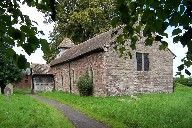 |
|
*****
VOWCHURCH, St. Bartholomew.
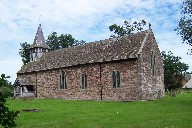 |
|
The nave and
chancel, which are continuous, like its
neighbour at Turnastone, were consecrated
in 1348, but incorporate the remains of
an earlier building. At the west end is a
timber bell turret, dated 1522.
The interior is a shock. To support a new
roof timber posts were set against the
stone walls to support the tie beams,
queen-posts and collar beams. It looks as
if a barn was built inside the original
walls in 1613, and at the same time the
carpenters added the chancel screen, the
only division between nave and chancel.
All this woodwork is stained black, and
claims that John Abel (1577-1674) was
responsible for this work are surely
misplaced, for it cannot begin to compare
with his work at Abbeydore and various
market halls throughout the county. |
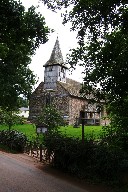 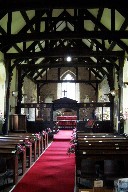 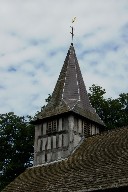
Tom Muckley, July 2007
tommuckley.co.uk
|
|